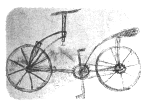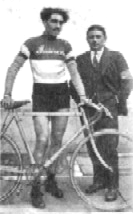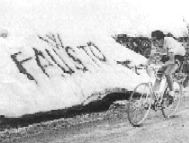
We're an all volunteer website and need your help to keep going. Here are five ways you can contribute: 1 Donate 2 Buy something 3 Submit a story 4 Volunteer 5 Advertise

New in the gift shop, virtualitalia.com logo wear and use items! 
|
PLEASE NOTE: We are experiencing unexpected
technical difficulties caused by our web host. We apologize for
the inconvenience. During your visit you may experience service
and page interruptions - we are in the process of fixing everything and hope to be
fully back on our feet soon.
italian bicycles through time
evolution of the bicycle
pedaling back to the top Beginning with Bianchi's early initiatives, Italy has transformed the construction of bicycles into an art form. Comparable to the precision and detail used to create Deruta ceramics, or the knowledge and care required to harvest a Super Tuscan, Italian Bicycle makers have transformed bicycle manufacturing into a highly skilled craft - mentored through generations of watchful artisans. Many agree that it is because of this long line of Italian frame building masters that the world craves the subtle synthesis of science and practiced skill that results in a beautiful and efficient Italian racing machine.
bike fads come and go - recent trends As the demand for mountain bikes began to swell, Italian manufacturers did not recognize the importance of the mountain bike phenomenon. The Italian bicycle industry found itself unprepared for the trend toward mountain bikes and reacted in a self-destructive way. In 1990, the newspaper "Gazzetta dello Sport" noted that many Italian firms were importing low-priced mountain bikes from Taiwan, adding Italian saddles, and selling them as Italian products. Contrary to their traditions of quality, creativity and technical innovation, Italian bike manufacturers sold low-priced and often poor quality mountain bikes. As a result, Italian manufacturers briefly lost their historic leadership position in the bicycle industry. In recent years, in order to regain their prominence in the bicycle industry and meet import competition, Italian manufacturers have increased their production of high-performance mountain bikes. Today, cycling is one of the most popular and increasingly important athletic activities in Italy. The successful introduction of mountain bikes, growing environmental awareness, more leisure time, and an expected increase of bicycles for commuting to work have all contributed to the bicycle's renewed popularity.
cyclo-tourism & sport Cycling as a sport, whether it is for participants or spectators, has always held a special place in the hearts of Italians . Professional bike races, including Italy's Giro, the Tour de France, and Spain's Vuelta, are followed passionately by the Italian people. This mass interest in cycling as sport helps to make Italians among the world's most knowledgeable consumers of bicycles, and leads to many passionate "discussions."
nuts & bolts of italian bicycles Most parts on Italian dimension bicycles are interchangeable with British/ISO dimensioned parts. The major exception is the bottom bracket. Italian bottom brackets are 70 mm wide, as opposed to the usual 68 mm dimension of British/ISO and French bottom brackets. The cup diameter is also larger. Sometimes, bicycles which have damaged bottom-bracket threads are machined out to Italian size to eliminate the damaged threads. Italian bottom brackets, like the French, use a right-hand thread on both sides, so the fixed cup is prone to loosening up unless very securely tightened. Italian threading is a curious mixture of metric and British measures. Diameters are specified in millimeters, but threads are in threads-per-inch. In addition, the thread angle is 55 degrees, like the obsolete British Whitworth system, rather than 60 degrees like U.S. and metric threads. Italian freewheel (basically extinct) and headset threads are the same as British/ISO, except for the thread angle difference. They may be interchanged, but you should not go back-and-forth between Italian and British/ISO headsets. View a brief listing of some of the most reputable and sought after Italian Bicycle manufacturers, including a brief history, a sample of their product, and contact information in Iitalian bicycle manufacturers.
Excerpts from "The bicycles and accessories market in Italy", January 1994, by A. Anselmini Dovigi, American Consulate General of Milan. |
© 1998-2005 by virtualitalia.com unless otherwise noted
 There is little dispute regarding the earliest and most comprehensive
drawings of what is considered to be the modern "bicycle." Around the year 1500, the great
Italian Leonardo DaVinci made several unmistakable sketches of a bicycle, complete with
pedals, handlebar steering, spoked wheels, and a chain driving the rear wheel
. Throughout the many years between DaVinci's sketches
and the sleek and rugged machines of today, engineers and technicians around the world
developed many variations of the bicycle. Adding at intervals pedals, steering, equal-sized
wheels, pneumatic tires and gears. As time elapsed, the bicycle evolved into a popular mode
of transportation, an entertaining leisure activity, and, before long, a competitive sport.
But not until the late 1800's did the Italians emerge within the biking industry to reclaim
the lead established by DaVinci's sketches to design and manufacture the world's greatest and
most innovative bicycles.
There is little dispute regarding the earliest and most comprehensive
drawings of what is considered to be the modern "bicycle." Around the year 1500, the great
Italian Leonardo DaVinci made several unmistakable sketches of a bicycle, complete with
pedals, handlebar steering, spoked wheels, and a chain driving the rear wheel
. Throughout the many years between DaVinci's sketches
and the sleek and rugged machines of today, engineers and technicians around the world
developed many variations of the bicycle. Adding at intervals pedals, steering, equal-sized
wheels, pneumatic tires and gears. As time elapsed, the bicycle evolved into a popular mode
of transportation, an entertaining leisure activity, and, before long, a competitive sport.
But not until the late 1800's did the Italians emerge within the biking industry to reclaim
the lead established by DaVinci's sketches to design and manufacture the world's greatest and
most innovative bicycles.
 The bicycle evolved in Europe in the 1790's from a little wooden horse with a fixed
front wheel. At first, you could only maneuver this bicycle-like-horse with your feet
because there were no pedals and the fixed front wheel prevented it from being steered.
It was subsequently improved in Germany in 1817, when baron Karl von Drais developed a
steerable front wheel to replace the fixed one. He called this invention a "dandy horse."
Soon thereafter in 1839, the first pedals were introduced by a blacksmith from Scotland,
Kirkpatrick Macmillan. As the bicycle continued its evolution, large front wheels remained
the norm, because it was believed that the bigger the front wheel, the faster the bike.
The bicycle evolved in Europe in the 1790's from a little wooden horse with a fixed
front wheel. At first, you could only maneuver this bicycle-like-horse with your feet
because there were no pedals and the fixed front wheel prevented it from being steered.
It was subsequently improved in Germany in 1817, when baron Karl von Drais developed a
steerable front wheel to replace the fixed one. He called this invention a "dandy horse."
Soon thereafter in 1839, the first pedals were introduced by a blacksmith from Scotland,
Kirkpatrick Macmillan. As the bicycle continued its evolution, large front wheels remained
the norm, because it was believed that the bigger the front wheel, the faster the bike.
 In the early
1880's, the English took credit for the development of the "safety bicycle," the precursor
to today's modern bicycle. This particular bike, the most similar resemblance to DaVinci's
earliest sketches, had a chain, sprocket driving rear wheel and equal sized wheels
. The years
that followed saw the development of pneumatic tires (1880's), two and three speed hub
gears (1890's), and derailleur gears (1899). The derailleur gear was the last major
innovation of bicycle design until the 1970's. At that time bicycles became more
aerodynamic and made use of more unconventional frames, and a new breed of bicycles,
the mountain bike, was born.
In the early
1880's, the English took credit for the development of the "safety bicycle," the precursor
to today's modern bicycle. This particular bike, the most similar resemblance to DaVinci's
earliest sketches, had a chain, sprocket driving rear wheel and equal sized wheels
. The years
that followed saw the development of pneumatic tires (1880's), two and three speed hub
gears (1890's), and derailleur gears (1899). The derailleur gear was the last major
innovation of bicycle design until the 1970's. At that time bicycles became more
aerodynamic and made use of more unconventional frames, and a new breed of bicycles,
the mountain bike, was born.
 In the late-1800's, an Italian by the name of Edoardo Bianchi picked up where his
fellow countryman, Leonardo DaVinci left off .
Bianchi took the modern bicycle, studied it, and envisioned its future as a slick
racing machine. At the time, the bicycle industry was growing, and Bianchi became
more intrigued by the prospect of bicycle as sport. Bianchi envisioned the newly created
sport as the ideal way to introduce the uninitiated masses to his bicycles. Putting his
idea into practice, Bianchi sponsored a young racer, Giovanni Ferdinando Tomaselli, in
the world's most prestigious cycling event, the 1899 Grand Prix of Paris (soon to be
the Tour de France). Tomaselli won the event, and secured forever Bianchi's (and Italy's)
place at the forefront of Bicycle design and craftsmanship.
In the late-1800's, an Italian by the name of Edoardo Bianchi picked up where his
fellow countryman, Leonardo DaVinci left off .
Bianchi took the modern bicycle, studied it, and envisioned its future as a slick
racing machine. At the time, the bicycle industry was growing, and Bianchi became
more intrigued by the prospect of bicycle as sport. Bianchi envisioned the newly created
sport as the ideal way to introduce the uninitiated masses to his bicycles. Putting his
idea into practice, Bianchi sponsored a young racer, Giovanni Ferdinando Tomaselli, in
the world's most prestigious cycling event, the 1899 Grand Prix of Paris (soon to be
the Tour de France). Tomaselli won the event, and secured forever Bianchi's (and Italy's)
place at the forefront of Bicycle design and craftsmanship.
 In the early 1990s, cyclo-tourism also gained popularity. Many specialized magazines
suggested tour itineraries throughout Italy, and a significant number of cyclo-tourist
associations were established.
The development of cyclo-tourism helped to stimulate the Italian tourism trade, and lead
to a greater demand for mountain and hybrid bicycles.
In the early 1990s, cyclo-tourism also gained popularity. Many specialized magazines
suggested tour itineraries throughout Italy, and a significant number of cyclo-tourist
associations were established.
The development of cyclo-tourism helped to stimulate the Italian tourism trade, and lead
to a greater demand for mountain and hybrid bicycles.